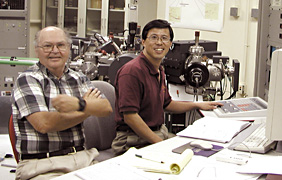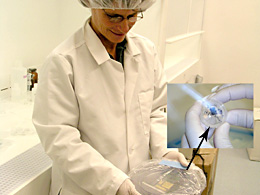
enlarge
image
Genesis Principal Investigator Don Burnett and ASU scientist Yunbin Guan analyzing Genesis materials in the ASU Secondary Ion Mass Spectrometry (SIMS) lab. The SIMS unit (background) generates an ion beam that mills material from the samples in a rastered pattern, and then directs the ejected material (also ions) into its mass spectrometer. Scientists count the number of solar wind atoms being measured during each raster. The solar wind ion counting rate is then quantified by comparing it to materials artificially implanted with the solar wind element of interest. If you would like to learn more about mass spectrometry and how it works, this site offers a high school activity titled: Genesis Sample Analysis: The Bottom Line (pdf doc.) with an online interactive to accoompany it.
+
SIMS interactive+ Read about Ion Microprobes in NASA's Planetary Science Research Discoveries Journal
|
Scientists at ASU Hard at Work Measuring Solar Wind
The Keck Labs, Materials Characterization Laboratory (CSSR), and SIMS laboratories at ASU are being used to clean, characterize, and analyze Genesis samples, and to prepare implanted standards to quantify analyses performed here and in other laboratories.

enlarge
image
ASU scientist, Amy Jurewicz, formerly Genesis Project Scientist at JPL, receiving materials artificially implanted with oxygen at Univ. of WI. These implants will be used to standardize (quantify) analyses on Genesis-flown materials (inset). |
|
|
 Find
out about the scientific building blocks of the Genesis mission
on the technical
Genesis mission Web site at the California
Institute of Technology. Find
out about the scientific building blocks of the Genesis mission
on the technical
Genesis mission Web site at the California
Institute of Technology.
 Learn
more about: Learn
more about:
the Genesis instrument team
at Los Alamos National Laboratory or the
Los Alamos
National Laboratory Genesis Data Web site.

|
